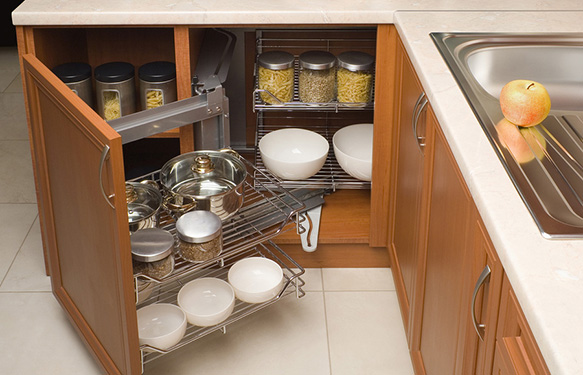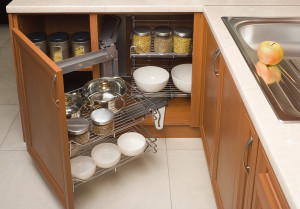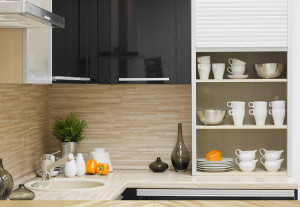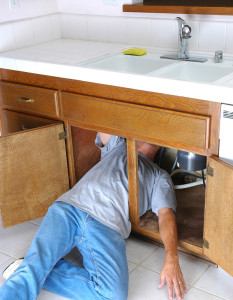Organizing Awkward Spaces Part I: Your Kitchen

23 Feb 2016
Organizing Awkward Spaces Part I: Your Kitchen
Welcome to our latest blog series: Organizing Awkward Spaces. In this series, we’ll cover all of those odd spaces you don’t know what to do with. Here in Part I, we’ll help you tackle those awkward spaces in your kitchen.
If you live in a small home, you are probably aware of the challenges of organizing: limited closet space, lack of cabinet space, no garage or attic, etc. If you live in an antique or pre-war home, like I do. One that has not undergone extensive renovations, you are likely also challenged with the space you have.
 Sometimes, regardless of the size, age or style of the home, there are awkward spaces that just seem impossible to organize or use effectively. We’ve all known someone who has moved into, or lived in a home where a prior owner did some amateur work on the place, or had an unusual need for a certain size or type of space that is then absolutely of no use to the new occupant!
Sometimes, regardless of the size, age or style of the home, there are awkward spaces that just seem impossible to organize or use effectively. We’ve all known someone who has moved into, or lived in a home where a prior owner did some amateur work on the place, or had an unusual need for a certain size or type of space that is then absolutely of no use to the new occupant!
To offer some suggestions for organizing awkward spaces in your kitchen, I have included actual examples of solutions to these issues that I have come across in my years as a Professional Organizer in Boston.
The Dreaded Lazy Susan Cabinet
Somehow, no matter what you do to design a kitchen, the inevitable question of what to do with the corner cabinets at their intersection, is solved by the Lazy Susan concept. A frustrating hinged, half louvered door that opens uneasily into a dark corner with a built in carousel, usually two-storied. The carousel spins, sometimes wobbling, sometimes squeaky, slowly, jerky or scraping. Either way, you catch your hand or fingers in the operation and those with young children dread losing their child into the abyss.
Nobody really enjoys storing kitchen items in these cabinets, even if the newly remodeled designs come with your kitchen! So what can you do with the mechanism behind the scary door?
Never store anything smaller than a mixing bowl in the space if possible. These rotating shelves are better for low height, squat items with some weight. Storing the waffle maker, hand mixer, juicer, two slice toaster, nested colander sets, stock pots and strainers are good candidates for these spaces. Avoid storing the standing mixer or anything too wide or heavy in this area.
If you must use the Lazy Susan cabinet for grocery storage, choose a category that will live in the space. For example, canned goods and soups (low sitting, heavier items), baking goods – flour or sugar, preferably in canisters, frosting cans, muffin and cake mixes. If you want to include smaller items like cupcake sleeves, decorating sugars and extract bottles, store these items first in a sealed container or a small, open sectioned bin to avoid them spinning right off the Lazy Susan and into the darkness.
Never store Tupperware or plastic storage containers on these shelves! They are too lightweight and their lids will fall off the back and underneath the spinning shelf and be lost forever!
The Bermuda Triangle Cabinet
 If you are really lucky, your kitchen has not only the lower cabinet Lazy Susan, but also the matching triangle cabinet on top! The angled design and short back wall and lots of vertical height make it challenging to decide what to store here. Most of my clients had given up on what to store there and just made it another catchall for all kinds of odd items.
If you are really lucky, your kitchen has not only the lower cabinet Lazy Susan, but also the matching triangle cabinet on top! The angled design and short back wall and lots of vertical height make it challenging to decide what to store here. Most of my clients had given up on what to store there and just made it another catchall for all kinds of odd items.
Surprisingly, the best solution is to turn your upper triangle cabinet into a Lazy Susan by adding a spinning tray, available at home stores in different diameters. By doing this, you can identify a category to be stored here. Recently, I installed two of the spinning trays in a client’s kitchen where there were three shelves available. You want to avoid the upper shelf as you likely won’t be able to reach that high to turn your tray. The trick to installing the spinning tray is to lift up the adjustable shelf (which hopefully it is) and slide the tray in on its’ side and then down, letting the shelf back down onto its’ support pegs.
On the top shelf it’s best to store serving pieces, tea pots, vases, lesser used items. On the lower shelf, to accommodate all of the sauces, oils and condiments, I used open top divided containers to hold taller liquids and to avoid anything toppling over. The shorter jars of jams, salsa and mustards sit nicely on the rubberized surface of the spinning tray.
I recommend using the middle shelf for some of your more frequently used cooking items like the go-to glass mixing bowl, glass measuring cups, ramekin dishes, and nesting bowls. In this way, you use the vertical space, but nothing was too high so that it would be vulnerable to falling over when the Lazy Susan is spinning. By creating storage sections by category in these cabinets, you will be less likely to just throw anything in them. And since most things don’t work stored in these spaces, this is the best way to use them effectively. Whatever the case, don’t overload them from front to back. No more than two items deep is ideal for ease of use.
Where No Man Has Ventured
 Sometimes, your kitchen has a corner cabinet where there has been nothing designed to use the space effectively. This is even worse than the dreaded Lazy Susan cabinet because it means that you have a corridor of dark, dust-filled space, usually adjacent to your sink area or where there is duct work nearby.
Sometimes, your kitchen has a corner cabinet where there has been nothing designed to use the space effectively. This is even worse than the dreaded Lazy Susan cabinet because it means that you have a corridor of dark, dust-filled space, usually adjacent to your sink area or where there is duct work nearby.
When I started work on a kitchen in a home built in the 1980s (a period of construction known for cutting corners and skimping on design) I came across one of these spaces. It was a continuous empty space from under the sink all the way to the right with no access after the sink cabinet door. There was about five feet of space overall. Underneath the sink, the homeowners had stored the usual kitchen cleaning supplies, dishwasher detergent, sponges, etc. To the right, were grocery bags, both paper and plastic.
As I started to move the grocery bags out of the corner, I realized that this was the only thing in about three and a half feet of space. The owner said she had been shoving bags in there since they moved in seven years ago because she thought that was all the space was good for! The bags just kept coming! The further I reached in the more compacted they had gotten over the years of shoving. Once I was waist deep in, I started to get nervous in the dark wondering what else I might touch back there.
After the bags were pulled out and piled behind me, the client called her husband into the kitchen to show him in horror, the stash of bags that came out of their cabinet depths. So now the question was, what should we do with the space? They weren’t planning on renovating, so the counter top and cabinet had to stay that way.
What I did was replace the kitchen cleaning items back underneath the sink in a cleaning caddy after eliminating anything that was not used there. If you have a small space, limit the number of products under your sink. Only have dish and dishwasher detergent, a few rags, a sponge or two, the refill for the hand soap and two or three all-purpose types of cleaners: counters, glass and disinfectant. The remainder should be in the bathroom cabinets and extras and seldom used, in the basement or pantry area. A cleaning caddy, available at any home store is good for containing the items and catches any spills or leaking chemical cleaners.
I asked my clients if they had any larger kitchen items that they seldom used, but wanted to keep nearby. Their three children were all involved in sports and they used small to medium sized coolers and drink dispensers to take for the team consumption at practice and games. They were currently sitting in a space on the floor next to the rear entry door. My client said she hated looking at them since they are plastic and not attractive.
Once the cleaning supplies were contained under the sink, we used a small over-the-door bag holder to retain a reasonable amount of plastic bags that the family used for messy garbage. To the right, once we wiped out the cobwebs, we stored about 6 medium sized coolers and drink dispensers. Everyone in the family agreed that this was a good place that they could access easily now. We also placed a small, LED push light just inside the cabinet on the right so that it wasn’t so dark and you could always see what was stored there.
The moral of this story, as you may have recognized, is that storing small, unruly things in awkward kitchen spaces is ill-advised when it comes to organizing.
Stay tuned for tips on organizing other awkward spaces.
By Kate Altieri: Professional Organizer, Organizing Boston
